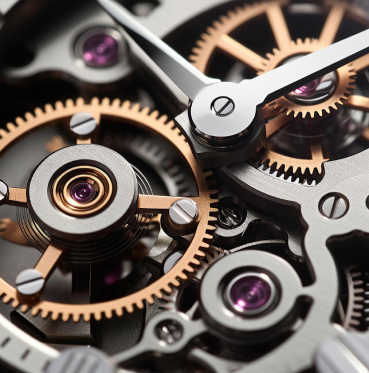Geneva Watch Days 2024
Armin Strom Fits The Dual Time GMT Resonance Into a New 39mm Size
Armin Strom Fits The Dual Time GMT Resonance Into a New 39mm Size
One of the most common criticisms of highly complicated watches is their size. As cool as Armin Strom’s original timepiece featuring the resonance principle was, its dimensions of 59mm by 43.4mm gave it an avant-garde look and considerable wrist presence. If you dig esoteric watchmaking but are also in the camp of preferring moderate or vintage sizing, you might especially appreciate the new Armin Strom Dual Time GMT Resonance First Edition that fits fascinating horology into a wearable 39mm case.
Understandably, any attempt to cram additional functions or mechanisms into a watch case can quickly see dimensions bloat. When tackling a remit to produce a watch that employs resonance, that task is even more daunting thanks to the necessary presence of not one but two regulating organs. The entire architecture of a movement must be reworked to accommodate a double-balance construction.
I’m a sucker for symmetry in watch design, specifically that of the movement, but it is very rarely achieved by single-oscillator watches (the overwhelming majority of watches on the market today). The dual oscillator construction, however, affords designers a significant advantage in that regard thanks to an almost 1:1 mirroring of components on both sides of the movement (which is effectively two separate movements operating simultaneously).
If one studies the caseback view of the Armin Strom Dual Time Resonance 39mm, only one visible deviation from true symmetry can be spotted — occurring almost exactly along the horizontal axis of the movement where the crown wheel occupies the left-hand side and is matched by a limitation plaque, indicating the model’s position in the sequence of the 25 pieces released, on the right.
Despite this slight divergence from pure symmetry, the mirroring is so close to perfect, it’s incredibly satisfying. The decision to deploy a limitation plaque rather than a dummy crown wheel was the right one (even if the latter, slightly whimsical suggestion would have titillated me, personally).
The truly significant thing about this new release from Armin Strom (aside from the brand once again flexing its muscles on the resonance front) is the size of the watch. While the resonance mechanism isn’t new for Armin Strom, the 39mm diameter of this, a round watch, is a massive step down in size from the previous oblong iteration of the same dual time concept, which measured a whopping 59mm by 43.4mm.
This has been accomplished by arranging the two separate movements that occupy the case in a vertical fashion and further refining their components so they occupy less space. Made from 18-karat white gold and water resistant to 50m, it is a surprisingly “sympathetic” slice of haute horlogerie.
So what is resonance and why does it matter?
In layman’s terms, it is the averaging out of the performance of two regulating organs with the intention of achieving more homogenous timekeeping (or, if you prefer, isochronism). The synchronization of these two balance wheels helps to minimize the effect of gravity as well as allowing the watch to recover quicker from impacts that would generally cause one of the two wheels to speed up and the other to slow down. Ultimately, it performs the same function as a tourbillon but is perhaps better suited to life on the wrist (whereas a tourbillon loves a pocket) due to the natural movement of the wrist effectively negating the tourbillon’s influence.
The phenomenon of “sympathetic resonance” was first noted by Dutchman Christiaan Huygens, who, having attached two pendulum clocks to a wooden beam, observed that they “communicated” with one another due to the vibrations of the beam connecting them caused by their individual movements. Huygens observed that the rate of the pendulums would eventually harmonize and that his discovery could potentially be applied to horology. Huygens, however, was no clockmaker, and thus the first meaningful experiments into the field of sympathetic resonance were conducted later by watchmakers such as Breguet and Janvier.
The same principle of using another material to transmit the almost imperceptible vibrations of the balance wheels to one another can be seen in F.P. Journe’s Chronomètre à Résonance, which attains sympathetic resonance via the baseplate both regulating organs share. In some ways, Journe’s method is therefore more akin to Huygens’ initial observations.
However, Armin Strom has taken this idea to the next level by creating a component with a singular role to play. The resonance clutch spring connects the two organs physically. It is a more “active” component than the baseplate of the movement as utilized by Journe, and it’s able to transfer information between the balances more quickly. It is finely tuned to perform its sole function, granting it meaningful separation from other influences that could more readily affect the resonant performance of the baseplate itself.
With over 20 in-house calibers to its name now, Armin Strom is perfectly placed to continue its modern dominance of the field of resonance, with wearable and subtly styled models like this one, making the brand a more attractive proposition by the day.
Tech Specs: Dual Time GMT Resonance – First Edition
Movement: Manual-winding Armin Strom manufacture Caliber ARF22; 42-hour power reserve
Functions: Hours and minutes; dual-time display; day/night indicator
Case: 39mm × 9.05mm; 18K white gold; 50m water resistance
Dial: Sky-blue grenage
Strap: Matt gray alligator strap with sky-blue stitching; additional light-gray alligator strap with pearl-gray stitching
Price: USD 120,700 / CHF 115,000
Availability: Limited to 25 pieces
Learn more at arminstrom.com
Armin Strom

















